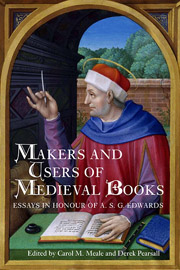Book contents
- Frontmatter
- Contents
- List of Illustrations
- Contributors
- Preface
- List of Abbreviations
- COMPOSITION
- COMPILATION
- PRODUCTION
- OWNERS, PATRONS, READERS
- Trinity College MS 516:A Clerical Historian's Personal Miscellany
- Katherine de la Pole and East Anglian Manuscript Production in the Fifteenth Century: An Unrecognized Patron?
- Past Ownership: Evidence of Book Ownership by English Merchants in the Later Middle Ages
- Early Printed Continental Books Owned in England: Some Examples in the Takamiya Collection
- AFTERLIVES
- A. S. G. Edwards: List of Publications
- Index of Manuscripts and Early Printed Books
- General Index
- Tabula Gratulatoria
Early Printed Continental Books Owned in England: Some Examples in the Takamiya Collection
from OWNERS, PATRONS, READERS
Published online by Cambridge University Press: 05 May 2014
- Frontmatter
- Contents
- List of Illustrations
- Contributors
- Preface
- List of Abbreviations
- COMPOSITION
- COMPILATION
- PRODUCTION
- OWNERS, PATRONS, READERS
- Trinity College MS 516:A Clerical Historian's Personal Miscellany
- Katherine de la Pole and East Anglian Manuscript Production in the Fifteenth Century: An Unrecognized Patron?
- Past Ownership: Evidence of Book Ownership by English Merchants in the Later Middle Ages
- Early Printed Continental Books Owned in England: Some Examples in the Takamiya Collection
- AFTERLIVES
- A. S. G. Edwards: List of Publications
- Index of Manuscripts and Early Printed Books
- General Index
- Tabula Gratulatoria
Summary
Early books printed on the Continent, imported into England in the late fifteenth and early sixteenth centuries, and bearing evidence of English ownership, have attracted growing interest among such book historians as Graham Pollard, Elizabeth Armstrong, Julian Roberts, Lotte Hellinga, Margaret Ford, and others. They have worked on the transitional period from late medieval to early modern as an integral part of the history of the book. Caxton's introduction of printing with movable type into England (c. 1476) stimulated book production there, mostly in English, by his followers, but Ford's seminal article ‘Importation of Printed Books into England and Scotland’, based on her database comprising some 4,300 books, has demonstrated that, despite this, the book trade in England in this period was dominated by imported Continental books. This resulted mainly from two phenomena: (a) ‘The introduction of printing intensified what was already emerging as a cultural division, or what may be viewed as the co-existence of two parallel worlds’, that is to say those who communicated in Latin and those who used the vernacular; (b) ‘The great printing houses of the Continent produced a steady stream of Latin works, from the classics of law, theology and literature (in ever improved versions), to modern works, all aimed at the whole world of learning of the “literati” including those in Britain‘. Most of these texts were imported in temporary bindings or unbound sheets, and bound properly in England, while some were purchased by scholars and recusants who travelled abroad.
- Type
- Chapter
- Information
- Makers and Users of Medieval BooksEssays in Honour of A.S.G. Edwards, pp. 178 - 190Publisher: Boydell & BrewerPrint publication year: 2014

